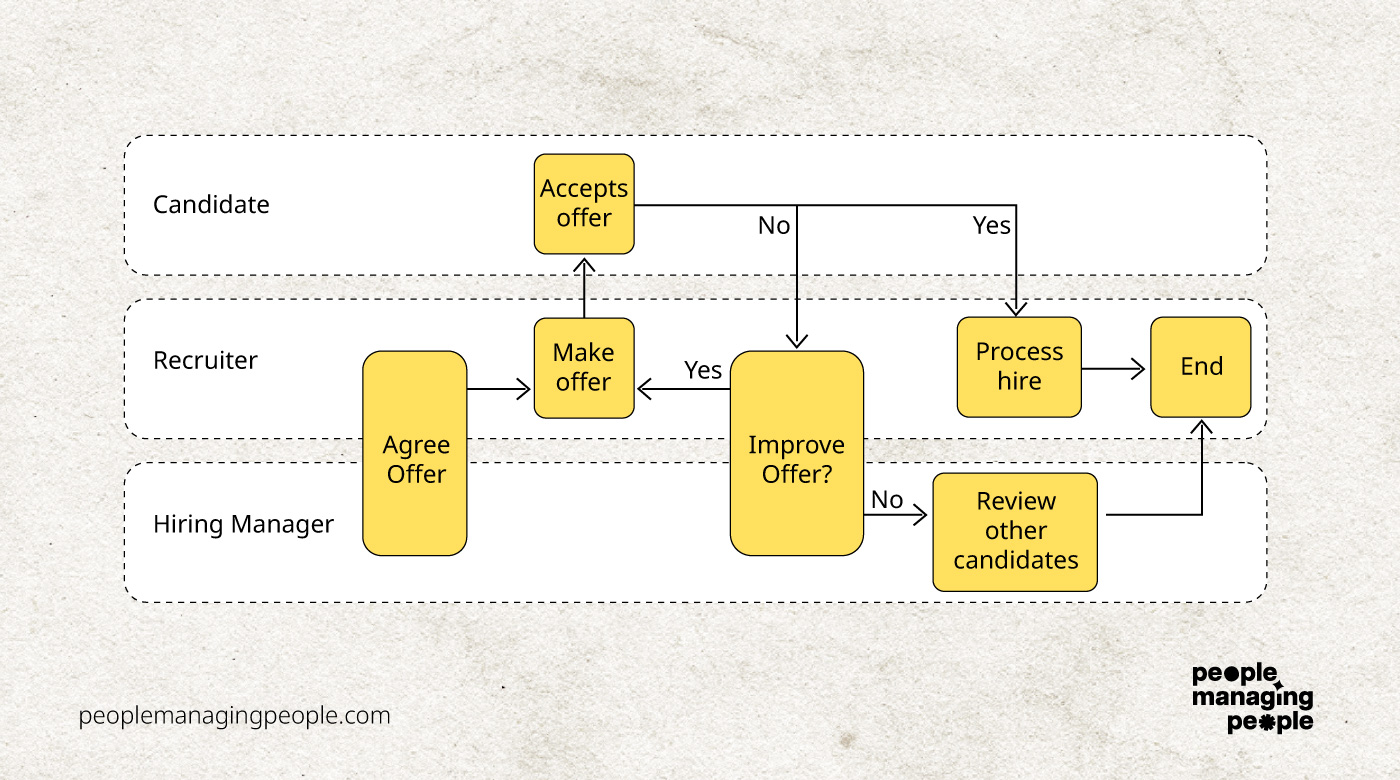Map Your Recruitment Path: Mapping your process against a skeleton process helps identify crucial elements, areas needing support, and clarifies recruitment activity purposes.
Document for Success: A well-documented recruitment process is essential for explaining nuances to managers, candidates, and stakeholders, and aids in measuring and improving recruitment efforts.
Better Process = Better Business: An improved recruitment process leads to lower recruiting costs, improved quality of hires, and better retention rates.
Whatever the size of your business, having a well-documented recruitment process is highly useful for explaining the nuances of recruiting to managers, candidates, and other stakeholders, and for measuring and improving your recruitment activity.
In this article, I’ll look at how you can map your process against a skeleton process to be able to see which elements are most important to you, which ones need more support, and more easily define the purpose of your recruitment activities.
Optimizing your recruitment process with talent acquisition tools can lead to improved candidate selection and faster hires.
But first, let’s clarify some basics.
What is Recruiting?
Recruiting is the process of attracting, screening, and selecting qualified candidates for a job within an organization. It’s what we all think of when we think of talent acquisition, which is a broader strategy encompassing the entire lifecycle of hiring—from identifying the need for new talent to onboarding successful candidates.
A recruiter database solution can help you track candidate progress, making the recruitment process more transparent and organized.
Recruiting is not just about filling vacancies though. It’s about finding the right people who will contribute to the company’s goals and culture.
In the broader context of human resources (HR) and organizational strategy, recruiting is integral. A well-defined recruitment strategy and process ensures that an organization can meet its current and future workforce needs, align with business objectives, and maintain a competitive edge.
8 Steps of the Recruiting Process
Most organizations can start with these basic eight steps, but as you can imagine, small business recruiting is a different animal than recruiting at a larger firm with more resources. So, depending on the size of your organization, your recruiting process flowchart will look different.
Each of these steps follows sequentially from the other so you can isolate each step to analyze and improve upon it. Whether you have a full cycle recruiting approach or something else, it will at least contain these steps.
Step 1: Identifying the need
The first step in the recruitment process is recognizing the need to fill a position. This involves a thorough assessment of the current workforce to determine if there are any gaps that need to be addressed.
Organizations forecast future needs based on business growth, project demands, or strategic shifts. Identifying the need is not just about filling an immediate vacancy, it's about workforce planning for long-term success and ensuring the organization has the right mix of skills and experience to achieve its goals.
Step 2: Creating a job description
Once the need for a new hire is identified, the next step is to create a job description. A clear and accurate job description that aligns with recruitment SEO tactics is ideal for attracting the right candidates.
The job description should include the job title, a detailed list of responsibilities, the qualifications and skills required, and any other pertinent information such as reporting structure and work conditions.
This document serves as the foundation for all recruitment efforts and sets expectations for both the employer and the potential candidates.
Step 3: Sourcing candidates
Sourcing candidates involves finding and attracting potential applicants for the job. This can be done through various methods, including:
- Job adverts—newspaper, online media, in-store, TV, radio, social media
- Recruitment agencies and headhunters
- Careers page/website
- Industry events and conferences
- Job fairs
- Referrals
- Social media—LinkedIn, Twitter, TikTok, etc.
- Talent communities—CRM, email newsletters, alumni networks
- Direct sourcing
- B2C connection.
When analyzing these, you need to delve into the metrics and identify which are the best sources of candidates for your business i.e. which provide you with the best candidates vs effort and resources spent.
Over time, you’ll discover those that are the most impactful based on your unique blend of candidate marketing and outreach. You can then fine-tune and ensure you display your employer brand/employer value proposition (EVP) in the best possible way.EVP) in the best possible way.
The table below takes the methods we listed above as the main categories and highlights which parts of that process you can focus on improving by increasing automation, improving the candidate experience, or adding resources.
I’ve broken these out into people, processes, and systems.
| Source | People Improvements | Process Improvements | System Improvements |
|---|---|---|---|
| Job adverts | Training your team on job advert writing—it’s a specific skill. Speak to managers and candidates about where they look for roles and advertise there too. | Have job adverts for your most common roles saved. Remember a job advert isn’t just the job description. Outsource this to a media buyer. Track the source of hire so you can optimise your spend. | Link your ATS to your most common places to post roles, some ATS systems have great functionality here. Tracking links on job adverts so you can be sure which media is working best. |
| Recruitment agency/ Headhunter | What's the engagement of the in-house team with the candidate—is there a pre-screen? | Setting up a defined preferred supplier list. Producing a factsheet for the recruiters to send candidates about you. Setting up agency briefing calls with managers. Having clear protocols for communication with agencies. Standardised terms and conditions for recruitment agencies to sign so you don’t have to have terms reviewed for every new supplier. | Linking agencies directly to your ATS so the manager experience remains consistent. Use of agency marketplace tools like Hiring Hub (this is UK only but easy to research if this type of product exists in your region |
| Careers website | Regular updates with fresh content | A big thing to look at here is whether your careers site is part of your ATS or its a separate entity and how your corporate site interacts with your careers site. Ensure in your job intake meeting you share the link with the hiring manager so they can share it with their networks. | Automated publishing of jobs straight to your careers site once approved Links to company socials |
| Industry events and conferences | Attendance from your recruitment team at as many events as possible, collect names, follow up and engage with potential candidates | Have the right materials: stands, brochures, pamphlets, etc that you can use at multiple events making them not “one-off” efforts | Listing attendance of events on your careers site |
| Job fairs | Attendance from your recruitment team at the right events. Do you need a dedicated campus recruitment team if this is a key source of hire | Have the right materials: stands, brochures, pamphlets, etc. that you can use at multiple events making them not “one-off” efforts | Listing attendance of events on your careers site and socials |
| Referrals | Spend time with your employees, speak to them about who they know at their previous company and who they would recommend. Regularly update the business to highlight roles available for referrals. | Review your incentivization methodology and policy. | There is specific software that manages referral incentives and tracks them. Many ATS providers have functionality in this space too. Can your ATS track referrals? |
| Social media - LinkedIn, Twitter, TikTok, etc. | Regular posts outlining company culture and highlighting roles Clear responsibility for which team this sits in eg Comms vs Talent Acquisition vs Marketing | Ensuring managers post their roles on socials | Creation of tracking links for socials from your ATS Automatic posting to socials from your ATS |
| Talent communities - CRM, email newsletters, alumni, etc | Curating a bespoke newsletter for candidates to send to different candidate groups Reviewing good candidates you’ve interviewed and seeing if they’re good for other roles and want to stay in touch | Capturing alumni as part of leaver process - develop specific referral programs for them to incentivize referrals. Automated links to join Talent Communities that can be on your careers site, apply pages, recruiter’s auto signatures, etc. | Automated job alerts and email marketing campaigns to candidate database Tracking links on each community so you can be sure of channel effectiveness. |
| Direct sourcing | Add additional resources to the direct sourcing team Develop specific sourcing roles. | Talent mapping: What roles will you look to hire in the future (through planned growth or expected attrition) and start to engage individuals ahead of time to speed up the process? Sit with hiring managers and go through LinkedIn Recruiter together, get them involved in this stage of the process. | Purchase LinkedIn Recruiter, Cord, or similar sourcing tools |
For system changes, you may find that you want to do things that your current applicant tracking system (ATS), or other recruiting software, doesn’t do.
Keep those pieces of functionality to one side as your tech bucket list and we’ll come back to them later in the article when we look at how to analyze the best technology provider for you.
Tip: Free recruiting platforms are invaluable for streamlining and tracking every step of the recruitment process.
Step 4: Screening and shortlisting
After sourcing candidates, the next step is screening applicants and creating a shortlist that of promising options. This process involves sifting through resumes and applications to identify those who meet the job criteria.
Resume screening solutions are essential when hiring for managerial positions, ensuring you focus on the right candidates.
The features of modern recruiting software can help streamline this process by filtering out unqualified candidates and ranking the most promising ones. Screening is critical to ensure that only the most suitable candidates move forward in the recruitment process.
There’s nothing worse than getting 5 minutes into an interview realizing that the candidate is unsuitable due to their salary expectations being way out of range, or that they don’t understand a key fundamental aspect of the role that clashes with their personal life such as shift patterns/travel expectations/days expected in the office, or that their skills really aren’t there.
You can lean on AI recruiting software to refine this process, automatically parsing data and highlighting potential conflicts or desirable skills and experience.
Let’s look at what the key issues are and how we check them.
| Item | People Check | Process Check | System Check |
|---|---|---|---|
| Salary expectation alignment | Conversation to establish expectation | Ensuring the salary is published in the application process (although this is a very blunt measure as it doesn’t represent the full package) the candidate can sense check themselves. | |
| Qualifications required for the role | Conversation to confirm and reaffirm that you will want to see documentation at Offer stage. | Clearly stated requirements in the job description. Questions asked in the application application stage. | Ability to reject candidates if qualification isn’t there. |
| Working conditions (shifts, hours, travel, in office/hybrid) | Conversation to confirm. | Clearly stated in the job description. Questions asked in the application application stage. | Ability to reject candidates if they aren’t aligned with working conditions. |
| Communication skills | Conversation to establish communication skills. | CV/Cover sheet Any questions you ask as part of the application process. | |
| Basic job requirements (language capability, programming ability, clarification on what’s on CV etc) | Reviewing CV. Conversation to establish basic capabilities. | Basic testing. | Ability to reject candidates if testing isn’t passed. |
| Motivation | Cover letter. Conversation to establish motivation. | Ask questions around motivation. |
Stage 5: Conducting interviews
Interviews are a key component of the recruitment process. They allow the employer to assess the candidate's qualifications, experience, and fit for the role. Using interview coordination software ensures that your recruitment process runs smoothly and without scheduling conflicts.
Different types of interviews—such as phone interviews, video interviews, and in-person interviews—serve different purposes. For example, phone interviews may be used for an initial screening, while in-person interviews are typically reserved for final candidates.
Preparing for interviews is essential. Interviewers should have a clear understanding of the role and the criteria they are assessing.
In my view, the most simple and straightforward principle to follow is that you need to assess each and every requirement you have in the job description, both the tasks to be done and the skills and experience required to perform them, and assign that to a step in the process (you can assign it to more than one).
For example:
- 5 years’ software development experience can be done in the review application and telephone screen process.
- Lead the Human Resources department in the EMEA region should be covered in the telephone screen and interview explaining to the candidate what this means and understanding their approach to doing it.
- Eye for design and detail (for a designer role) can be assessed by reviewing a portfolio and the use of an employment test assignment.
You get the idea—don’t put anything in the job description that you don’t want to assess and make sure you assess everything in the job description during the process (otherwise remove it).
So an example interview process could look like this (I’ve added the recruiter as an interviewer but that is obviously up to you).
| Stage | Who | To Cover |
|---|---|---|
| 1st | Hiring Manager (with others potentially involved if you interview in pairs or groups). | Skills required to do the role (this clearly has to be the line manager’s core assessment—can they do the job). Chemistry—can we work together? Motivation—we should have an idea already but a deeper dive can be taken. Culture and values—aligned with chemistry but this is more of a fit for the organization. |
| 2nd (part one) | Recruiter (if this is the role of the TA function, if not this probably goes to 1st interview). | Culture and values—is this person a good fit for the organization? Review of anything highlighted by the 1st interview or wasn’t covered. Sense check on salary and working conditions. |
| 2nd (part two) | Hiring Manager’s Manager | Motivation Team alignment Review of anything highlighted by the 1st interview or wasn’t covered Any presentation required |
This is a standard template I’ve used as the starting point for planning your interview process but, obviously, not every role is the same and you may want more of a collaborative hiring process.
In some markets and cultures having too many steps slows the process down too much, so I try and keep it to two maximum, but for some roles it’s fine to have more.
Having two interviews in a process does give you some obvious advantages and having time to think and compare candidates before meeting them again is useful.
I’ve been in many processes where our expectations of what we could hire didn’t match reality.
When you’ve met five well-screened people, none of whom are perfect but who are all demanding the top of your salary range, this indicates you might need to compromise on something.
Step 6: Assessing and selecting candidates
Once interviews are conducted, the next step is to assess and select the best candidate. This involves evaluating the candidates based on their qualifications, experience, and how well they fit with the company culture.
Additional tools such as reference checks, HR background check systems, and employment tests can provide further insights into the candidate's suitability. The selection process should be thorough to ensure that the best possible hire is made.
You need some objective measure of the candidates you interview but I’m wary of the dangers of too much focus on a score because it can over-emphasize someone who says the right thing over someone who does the right thing.
A score is useful to sift out those who clearly aren’t right, but it is risky to think you have to offer the job to the person with the highest score.
Finish with a collective wrap-up and assessment of the candidates (my suggestion is to review them from the lowest score first), some principles to cover this:
- Give feedback scores to the recruiter after the interview
- Avoid side discussions about candidates before the wrap-up meeting (it’s hard but it runs the risk of groupthink)
- Recruiter collates scores and starts with lowest first with the following agenda:
- Recruiter shares collective score, give their thoughts and a would hire/wouldn’t hire/might hire
- Hiring manager’s manager gives their thoughts and would/wouldn’t/might
- Hiring manager does the same
- Collate feedback to be given and who will give it
- Repeat for all candidates
- Review those with most yes’s and agree who to offer the role to (be clear on who has the final decision here).
Stage 7: Offer
After selecting the top candidate, the organization needs to extend a job offer. This step involves negotiating the terms and conditions of employment, including salary, benefits, and start date.
Clear communication is crucial during this stage to ensure that both parties are aligned on expectations. A well-crafted job offer that addresses the candidate's needs and concerns can help secure their acceptance and start the employment relationship on a positive note.
One lesson I’ve learned over the years is that this part of the process is highly emotive.
We’ve been through a long selection process that’s involved and draining for both parties and now there’s money on the table.
I’ve seen hiring managers want to offer people well below what they’ve asked for because the manager took the role for that money when they joined or because they want to test them with a low offer to assess engagement or refuse to offer a few % more because of recruiting budget constraints or team inequity.
Things can go wrong quickly here and, if emotions get stirred up between the candidate and hiring manager, a future critical working relationship can become damaged.
I learned some of these lessons the hard way. When job markets had moved fast and we were behind with what we should have been paying, our TA team had a view, our HR team had a view, and managers had their own individual views.
This became quickly chaotic and, by measuring our offer-to-acceptance ratio, we quickly used evidence to get everyone on the same page and fix the problem.
I’m a big believer that TA teams should have a strong voice in these discussions as they talk to the market in real-time. Here’s an outline process that involves the hiring manager, recruiter, and candidate.

Again, this is just a suggestion, and your organization will work differently, but this outline is a good starting point and the key items in the steps are fairly universal.
Clearly, expectations, interview feedback, and team and salary benchmarking are required data points for this.
You need to be clear about who the final decision maker is, but I feel the recruiter’s input is critical here to avoid a lowball offer and ensure there is company-wide consistency in line with your compensation philosophy.
Stage 8: Onboard
Employee onboarding is the final step in the recruitment process. Onboarding includes orientation, training, and integrating the new employee into the company culture.
A comprehensive onboarding process helps them understand their role, build relationships with colleagues, and become productive members of the team. Effective onboarding can also increase employee retention and satisfaction.
The most important things you need to focus on here are being clear on who’s the main point of contact for your new hire, who will be in touch with the candidate, and what documentation is required to be completed before someone joins.
Your setup and how much automation there is in the process etc. should indicate who the best point of contact is in your business, but I think there are some points to consider.
- The manager has to be in touch with the new hire regularly.
- There should be someone from HR ensuring that as much documentation is completed as possible before the hire starts. This should be someone who understands benefits and onboarding well and, in my view, shouldn’t be the recruiter as they should be hiring the next person
- Make sure you talk (not text or email) the candidate through this part of the process. Waiting to start a new job is a strange time so engage with them
- Get as much automation as possible in this part of the process that your systems will allow.
- Make sure it's super clear to the new person what will happen on their first day/week/month.
Benefits of an Effective Recruiting Process
Obviously this is a lot of work to implement something like this. So why bother? Well, here are some benefits that you'll likely experience by improving how you recruit.
Improved quality of hire
A well-structured recruitment process directly leads to better hiring decisions. By following a defined process, organizations can ensure that they are selecting candidates who not only have the right skills and experience but also fit well with the company culture.
This results in higher-quality employees who are more likely to perform well and contribute positively to the organization.
Increased retention and cost savings
Streamlining the recruitment process saves time and resources, which can significantly reduce hiring costs. Additionally, hiring the right candidates from the start decreases turnover rates, leading to long-term cost savings.
According to Gallup, replacing an individual employee can cost between half and twice their annual salary. For a 100-person company that prioritizes talent retention, this could translate to more than $2 million in annual cost savings.
High employee retention also fosters a more stable and engaged workforce, which is beneficial for overall productivity.
Enhanced employer brand
The recruitment process is often the first point of contact between a potential employee and the organization. A positive recruitment experience can enhance the company's reputation as a desirable place to work. This, in turn, can attract more top talent in the future and strengthen the employer brand.
Wrapping Up
Having a clearly understood recruiting process will benefit your business through repetition. This doesn’t mean your process becomes robotic—if you’re all doing the same things time and time again you’ll get more efficient and quicker and make better, more consistent decisions around hiring.
You’ll also become adept at using recruitment data and analytics to identify opportunities for streamlining your recruitment process and discover opportunities for recruitment automation.
Be brave about listening, use your process maps to discuss where things went wrong, and work with stakeholders to improve them. An interactive approach will always work best.





